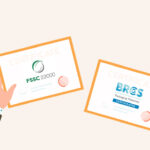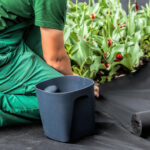Introduction
In packaging, PP (Polypropylene) and BOPP (Biaxially Oriented Polypropylene) bags are widely used due to their durability and versatility. PP bags, made from polypropylene, are known for being lightweight and moisture-resistant. BOPP bags, also made from polypropylene, undergo a special process that enhances their strength and clarity. Understanding the differences between these bags is crucial for choosing the right one for your needs. This blog compares PP and BOPP bags in terms of composition and properties. It helps you make an informed decision for various applications.
Understanding PP Bags
PP or polypropylene bags are popular in various industries due to their strength, durability, and flexibility. Made from a type of plastic called polypropylene, these bags are designed to handle everything from small items to large volumes of goods. Let’s explore their common uses, applications across different industries, and examples of products typically packaged in these versatile bags.
Applications in Different Industries
Polypropylene bags are not limited to any single industry. They serve various purposes across multiple sectors:
- Agriculture: Farmers use PP bags to store and transport seeds, feed, and fertilizers.
- Retail: Many retail stores use these bags to package products like clothes, shopping bag, books, and other goods.
- Pharmaceuticals: In the pharmaceutical industry, they are used to package medicines and health supplements safely.
- Construction: These bags are also used in construction to hold and transport materials like sand, cement, and chemicals.
Polypropylene bags are a reliable choice for multiple packaging needs across industries due to their adaptability, durability, and cost-effectiveness. Whether for daily groceries or specialized industrial use, PP bags offer a practical solution for keeping goods safe and secure during transport and storage.
Understanding BOPP Bags
BOPP bags, which stand for Biaxially Oriented Polypropylene bags, are a specific type of packaging material known for their clarity, strength, and excellent printing capabilities. These features make them a popular choice in various sectors for packaging goods that need both protection and visual appeal.
Features
BOPP bags are known for several distinct features:
- High Clarity: Not all BOPP bags are very clear, but at Anita Plastics, we design clear BOPP bags customized to meet customer demands.
- Strong and Durable: The biaxial orientation of polypropylene increases its strength and durability.
- Moisture Resistant: They provide great protection against moisture, keeping the contents dry and safe.
- Great for Printing: BOPP films are ideal for high-quality printing, so the bags often feature vibrant, eye-catching designs.
Applications in Different Industries
BOPP bags are versatile and find applications in a range of industries, including:
- Food Industry: Ideal for packaging snacks, cookies, candies, and other confectioneries.
- Pet Food: Used for packaging various types of pet food.
- Agriculture: Utilized for packaging seeds, fertilizers, and other agricultural products.
- Construction: Suitable for packaging construction materials such as cement and sand.
BOPP bags continue to be a favorite choice for packaging needs that require durability and a clear display of the contents. Their ability to protect while showcasing the product inside makes them invaluable across multiple industries.
Manufacturing Process of PP Woven Bags and BOPP Bags
The manufacturing processes for PP woven bags and BOPP bags share some similarities, mainly in using polypropylene as the primary material. Still, they also have distinct differences, particularly in the treatment and finishing of the material.
Manufacturing Process of PP Woven Bags
- Extrusion Process: Polypropylene pellets are heated and melted to form a flat film, which serves as the base material for further processing.
- Winding Process: The flat film is wound onto large rolls, preparing it for the next stages of production.
- Weaving Process: Polypropylene tapes are woven into a durable fabric, forming the foundational structure of the woven product.
- Printing Process: The woven fabric is printed with customized designs or branding, tailored to specific requirements.
Manufacturing Process of BOPP Bags
- Extrusion Process: Polypropylene pellets are heated and melted to form a flat film, creating the base material for further processing.
- Winding Process: The flat film is wound onto large rolls, making it ready for the next stages of production.
- Lamination: A BOPP film is laminated onto the woven polypropylene fabric, enhancing its strength and durability.
- Weaving Process: Polypropylene tapes are woven into a sturdy fabric, which serves as the foundational structure of the bag.
- Extrusion Coating: A protective coating is applied to the woven fabric, providing additional barrier properties and durability.
- Printing Process: The laminated fabric is printed with customized designs or branding to meet specific requirements.
Key Differences Between PP Bags and BOPP Bags
PP and BOPP bags are made from polypropylene, a versatile plastic. Still, they differ in how they’re manufactured and their resulting properties. Let’s dive into these differences:
Material Composition
- PP Bags: These are made from polypropylene woven fabric. The fabric is made by weaving polypropylene strips, creating a strong and durable material.
- BOPP Bags: These bags start with a similar polypropylene base but include a Biaxially Oriented Polypropylene (BOPP) film. This film is applied to the surface of the woven fabric, enhancing the bag’s features.
Differences in the Polymer Structure and Orientation
- PP Bags: The polypropylene in these bags is not oriented; it’s woven into fabric. This means the material has random polymer alignment.
- BOPP Bags: The BOPP film involves stretching the polypropylene in two directions. This orientation aligns the polymers more orderly, enhancing clarity and strength.
Impact on Properties and Performance
Durability and Strength
- PP Bags: These bags are highly durable and suitable for heavy-duty applications. They can handle rough handling and heavy loads, making them ideal for industrial and agricultural uses.
- BOPP Bags: While strong, the added BOPP film offers enhanced tear resistance. However, they might not be as suited to extremely rough conditions as PP bags.
Tensile Strength and Resistance to Wear and Tear
- PP Bags: Excellent for carrying heavy materials due to their strong woven structure.
- BOPP Bags: Also strong but with a smoother surface that might be less prone to snagging .
Suitability for Heavy-duty vs. Delicate Applications
- PP Bags: Preferred for heavy-duty applications like transporting feed, fertilizers, or sand.
- BOPP Bags: Better suited for delicate or premium applications, such as retail packaging, where appearance is important.
Barrier Properties
Moisture and Chemical Resistance
- PP Bags: Good resistance to moisture, making them suitable for outdoor applications.
- BOPP Bags: Offers excellent barrier properties against moisture and chemicals due to the BOPP film’s protective layer.
Effectiveness as a Barrier against Contaminants
- PP Bags: Provide a decent barrier but are less impervious than BOPP bags.
- BOPP Bags: Superior in preventing contaminants from reaching the product, ideal for food and hygiene-sensitive items.
Printability and Aesthetic Appeal
Quality of Print and Design Possibilities
- PP Bags: These can be printed on, but the print quality could be sharper than that on BOPP bags.
- BOPP Bags: Supports high-quality graphic printing, making designs vibrant and detailed, ideal for consumer-facing products.
Glossy Finish and Matte Finish
- PP Bags: Usually have a matte finish, which is less reflective and more subdued.
- BOPP Bags: Depending on the desired visual appeal, BOPP bags can have either a glossy or a matte finish. The glossy finish is particularly popular for retail products due to its eye-catching shine.
Functional Advantages of PP and BOPP Bags
Both PP and BOPP bags offer unique advantages that make them suitable for a variety of uses. Here’s a look at the functional benefits of each type of bag, explained in simple terms.
PP Bags
- Cost-effectiveness: PP bags are very affordable, making them a popular choice for many businesses, especially when large quantities are needed. Due to their durability and strength, they provide good value for money.
- Versatility and General-Purpose Use: These bags are extremely versatile and can be used for a range of applications. Whether for storing agricultural products, transporting building materials, or packaging retail items, PP bags can handle it all.
- Recyclability: PP bags are recyclable, which means they can be processed and used to make new products. This feature is crucial for companies looking to reduce their environmental impact and promote sustainability.
BOPP Bags
- Enhanced Durability and Strength: BOPP bags are stronger and more durable than many other types of bags thanks to the biaxially oriented polypropylene film. This makes them excellent for packaging products requiring extra transport or storage protection.
- Superior Barrier Properties: BOPP bags offer exceptional protection against moisture, dust, and other contaminants. Their barrier properties are superior, which is particularly important for food products or any goods that must stay clean and dry.
- High-quality Printability and Aesthetic Appeal: One of the standout features of BOPP bags is their ability to support high-quality printing. The prints on these bags are clear, vibrant, and detailed, making them ideal for retail products where visual appeal can influence consumer decisions. These bags look great on store shelves, whether glossy or matte finish.
- Recyclability: Like PP bags, BOPP bags are also recyclable. This makes them a responsible choice for businesses conscious of their environmental impact. Recycling these bags helps conserve resources and reduce waste.
Both bags have unique advantages, making them suitable for different needs. PP bags offer practicality and cost-effectiveness for a wide range of applications. In contrast, BOPP bags provide enhanced protective features and visual appeal, making them ideal for products that require a bit of extra care and attention on the display front. Whether it’s durability, barrier protection, or aesthetic requirements, choosing the right type of bag can significantly impact the effectiveness of product packaging.
Industry-Specific Applications
PP and BOPP bags serve crucial roles across various industries due to their unique properties. Let’s explore how they are used in the food industry, agriculture, and industrial sectors, comparing their suitability and performance.
Food Industry
Here’s a table comparing PP and BOPP bags for food packaging in terms of their suitability, properties, and typical applications:
| Feature | PP Bags | BOPP Bags |
| Primary Use | Bulk food items | Consumer-facing products |
| Suitability | Large quantities, where durability is crucial | Products requiring visual appeal |
| Cost-effectiveness | High | Moderate |
| Durability | Very strong and suitable for heavy items | Strong with added resistance to tears |
| Barrier Properties | Good resistance to moisture | Superior resistance to moisture and contaminants |
| Printability | Limited | High-quality printability |
| Visual Appeal | Functional, less focus on aesthetics | High visual appeal with options for glossy or matte finishes |
| Typical Products | Rice, flour, sugar | Snacks, pasta, cereals |
This table should help illustrate the key differences and benefits of each type of bag depending on their intended use within the food industry.
Agricultural Sector
Here’s a table comparing PP and BOPP bags for agricultural products, focusing on their durability and resistance to environmental factors:
| Feature | PP Bags | BOPP Bags |
| Primary Use | Packaging seeds, fertilizers, and agricultural goods | Specialty agricultural products requiring visual appeal |
| Durability | Highly durable, can handle rough handling | Durable but better suited for less rough handling |
| Resistance to Environmental Factors | Excellent resistance to moisture, UV, and tearing | Good moisture resistance, somewhat less robust against UV and tearing |
| Barrier Properties | Good protection from dust, moisture, and pests | Superior moisture barrier but not necessarily needed for most bulk agricultural goods |
| Aesthetics | Functional, less concern for appearance | High-quality printing and clearer visibility for premium products |
| Typical Products | Bulk packaging , animal feeds, fertilizers | Packaged specialty seeds, decorative agriculture products |
This table highlights the distinctions between PP and BOPP bags, especially in terms of their suitability for different types of agricultural products, with a focus on durability and environmental resistance. PP bags are generally preferred for their robustness in traditional agricultural settings, while BOPP bags are chosen for speciality or premium products where appearance and moisture barrier are more critical.
Industrial Uses
Here’s a comparison table for PP and BOPP bags used in packaging for chemicals, construction materials, and other industrial products, highlighting differences in suitability and performance:
| Feature | PP Bags | BOPP Bags |
| Primary Use | Packaging heavy or abrasive industrial materials | Packaging where additional barrier and aesthetic are needed |
| Suitability | Highly suitable for rugged, heavy-duty applications | Suitable for less rugged, cleaner industrial products |
| Durability | Extremely durable, suitable for heavy and abrasive materials | Durable, but better for products that require less structural toughness |
| Resistance to Environmental Factors | High resistance to moisture, tearing, and wear | Good moisture and chemical resistance, but not as tough against physical wear |
| Barrier Properties | Good, particularly for dry bulk materials | Excellent, particularly effective against moisture and vapours |
| Printability | Moderate, suitable for basic labeling | High-quality printability for detailed labeling and marketing |
| Aesthetic Appeal | Less emphasis on aesthetics, more on functionality | High, often used when product visibility and branding are important |
| Typical Products | Construction materials, bulk chemicals, fertilizers | Specialty chemicals, consumer-facing industrial products |
This table illustrates that PP bags are generally preferred for more demanding industrial uses due to their strength and durability, making them ideal for heavy or abrasive materials. In contrast, BOPP bags are used when the packaging needs not only to protect but also to display or market the product effectively, thanks to their superior barrier properties and printability.
In conclusion, both PP and BOPP bags provide excellent packaging solutions, each with distinct advantages tailored to different needs. PP bags are prized for their durability and cost-effectiveness, making them ideal for heavy-duty applications in industries like agriculture and construction. On the other hand, BOPP bags excel in situations where barrier protection and aesthetic appeal are paramount, such as in the food and speciality chemical sectors. Choosing between PP and BOPP bags depends on the specific requirements of the product and the industry, balancing factors like strength, visibility, and environmental resistance to find the most effective packaging solution.




